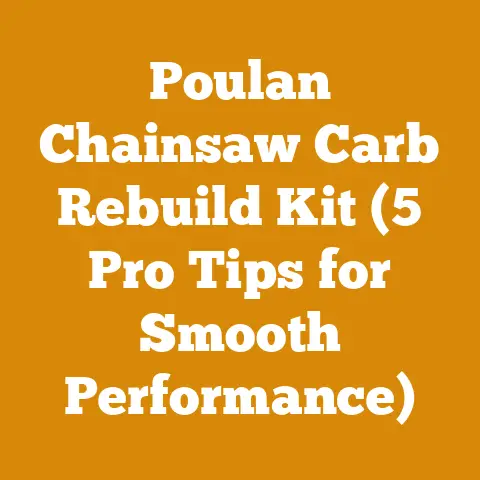Cost to Rent a Bucket Truck (5 Pro Tips for Arborists)
As someone who’s spent years felling trees and wrestling with timber, even once winning the regional “Logger’s Games” for fastest firewood stacking, I understand the critical role specialized equipment plays in arboriculture. Today, I’m diving deep into the cost of renting a bucket truck, coupled with five pro tips specifically tailored for arborists. Trust me, this isn’t just about saving money; it’s about safety, efficiency, and making the right choices for your business.
Cost to Rent a Bucket Truck (5 Pro Tips for Arborists)
Bucket trucks, also known as aerial lifts, are indispensable tools for arborists. They allow safe and efficient access to tree canopies for pruning, trimming, removal, and inspection. However, purchasing a bucket truck can be a significant investment, especially for smaller businesses or those just starting. Renting offers a flexible and cost-effective alternative. But how do you navigate the rental market to get the best deal and ensure you’re making the right choice? Let’s break it down.
Understanding the Costs: A Deep Dive
The cost of renting a bucket truck varies significantly depending on several factors:
- Truck Size and Reach: Smaller trucks with a reach of 30-40 feet are less expensive than larger models that can reach 75 feet or more.
- Rental Duration: Daily, weekly, and monthly rates are available. Longer rental periods typically offer lower per-day costs.
- Truck Features: Insulated booms for working near power lines, four-wheel drive, and other specialized features will increase the rental price.
- Location: Rental rates vary by region, with higher costs in urban areas or regions with high demand.
- Vendor: National rental chains like United Rentals and Sunbelt Rentals often have more consistent pricing, while local rental companies may offer more competitive rates.
- Insurance: Rental companies typically require proof of insurance or will offer coverage at an additional cost.
- Delivery and Pickup: Transportation costs can add to the overall expense, especially for long distances.
Typical Rental Rates (2024):
- Daily: $300 – $1,000+ (depending on size and features)
- Weekly: $1,200 – $4,000+
- Monthly: $3,500 – $12,000+
Data Point: According to a 2023 survey by the Tree Care Industry Association (TCIA), the average hourly rate for tree work involving a bucket truck is $150 – $300. Efficient use of a rented bucket truck is crucial to maintaining profitability at these rates.
Real-World Example: I once rented a 45-foot bucket truck for a week to tackle a large-scale pruning project in a residential area. The rental cost was $1,800, but the efficiency gains allowed me to complete the project in half the time compared to using ladders and climbing gear. This translated to significant savings in labor costs and increased profitability.
Pro Tip #1: Plan Ahead and Reserve in Advance
Don’t wait until the last minute to book your bucket truck. Rental companies often have limited inventory, especially during peak seasons. Reserving in advance ensures you get the truck you need and allows you to compare rates from different vendors.
- Actionable Advice: Start your search at least two weeks before your project begins. Contact multiple rental companies to get quotes and inquire about availability.
- Benefit: Securing your rental early can also give you leverage to negotiate a better price.
Pro Tip #2: Inspect the Truck Thoroughly Before Accepting It
Before signing the rental agreement, conduct a thorough inspection of the bucket truck. This includes:
- Mechanical Inspection: Check the engine, hydraulics, brakes, and tires. Look for any signs of leaks, damage, or wear.
- Safety Features: Verify that all safety devices, such as outriggers, alarms, and emergency shut-off switches, are functioning properly.
- Boom Operation: Test the boom’s range of motion, stability, and responsiveness.
- Documentation: Ensure you have all the necessary manuals and safety information.
Wood Science Insight: Understanding the load capacity of the bucket truck’s boom is crucial. Overloading the boom can lead to structural failure, especially when dealing with heavy limbs. Remember, green wood is significantly heavier than seasoned wood.
Real-World Example: I once rented a bucket truck that had a faulty hydraulic cylinder. I didn’t notice it during the initial inspection, and it failed mid-job, causing a significant delay and potential safety hazard. Lesson learned: always test every function before accepting the truck.
Actionable Advice: Create a checklist of items to inspect before accepting the truck. Take photos or videos of any existing damage to avoid being charged for it later.
Pro Tip #3: Choose the Right Truck for the Job
Selecting the appropriate bucket truck is crucial for efficiency and safety. Consider the following factors:
- Reach: Determine the maximum height you need to reach. Add a few extra feet for safety and flexibility.
- Terrain: Choose a four-wheel-drive model if you’ll be working on uneven or sloped terrain.
- Power Lines: If you’ll be working near power lines, opt for a truck with an insulated boom.
- Bucket Capacity: Ensure the bucket can safely accommodate the weight of the arborist and their tools.
- Maneuverability: Consider the truck’s size and turning radius, especially if you’ll be working in tight spaces.
Data Point: According to the Occupational Safety and Health Administration (OSHA), falls from elevation are a leading cause of death and injury in the tree care industry. Using the right bucket truck for the job can significantly reduce the risk of falls.
Logging Tool Selection and Maintenance Best Practices: Proper maintenance of your arborist tools is essential when working with a bucket truck. Sharp chainsaws, well-maintained ropes, and properly functioning safety gear are crucial for a safe and efficient operation.
Real-World Example: I once saw a crew using a bucket truck that was too small for the job. They had to overextend the boom, which made the truck unstable and created a dangerous situation. Choosing the right truck from the start would have saved time, money, and potential injury.
Actionable Advice: Consult with the rental company’s representative to determine the best truck for your specific needs. Provide them with detailed information about the job site and the types of trees you’ll be working on.
Pro Tip #4: Negotiate the Rental Rate
Don’t be afraid to negotiate the rental rate. Rental companies are often willing to offer discounts, especially for longer rental periods or repeat customers.
- Research: Compare rates from multiple vendors to get a sense of the market price.
- Negotiate: Ask for a discount if you’re renting for a week or longer.
- Bundle: Inquire about discounts for renting multiple pieces of equipment.
- Cash Discount: Some rental companies offer a discount for paying in cash.
Data Point: A 2022 study by the American Rental Association (ARA) found that renters who negotiate their rental rates save an average of 10-15%.
Firewood Seasoning Techniques and Safety Considerations: Understanding the principles of wood drying is essential for arborists who also deal with firewood. Properly seasoned firewood burns more efficiently and produces less smoke. Safe handling practices are crucial when processing and stacking firewood.
Real-World Example: I once negotiated a 10% discount on a monthly bucket truck rental by agreeing to pay in cash. This saved me several hundred dollars.
Actionable Advice: Be polite but persistent when negotiating. Highlight your experience and your commitment to safety.
Pro Tip #5: Prioritize Safety Training and Certification
Operating a bucket truck requires specialized training and certification. Ensure that all operators are properly trained and certified before using the equipment.
- OSHA Standards: Familiarize yourself with OSHA’s requirements for aerial lift operation.
- Training Programs: Enroll operators in accredited training programs that cover topics such as pre-operation inspections, safe operating procedures, and emergency procedures.
- Certification: Obtain certification from a recognized organization, such as the International Society of Arboriculture (ISA).
Wood Anatomy and Properties: Understanding the structure and properties of wood is crucial for arborists. Knowing the difference between hardwood and softwood, and how wood reacts to different environmental conditions, can help you make informed decisions about tree care and removal.
Real-World Example: I once worked with a crew that had not received proper bucket truck training. They made several mistakes that could have resulted in serious injury. Investing in training is not just a good idea; it’s a necessity.
Actionable Advice: Verify that all operators have the necessary training and certification before allowing them to operate the bucket truck. Conduct regular safety meetings to reinforce safe operating procedures.
Project Planning and Execution
Careful project planning is essential for maximizing the efficiency and safety of your bucket truck rental.
- Site Assessment: Assess the job site to identify potential hazards, such as power lines, underground utilities, and traffic.
- Tree Assessment: Evaluate the trees to be worked on, noting their size, species, and condition.
- Work Plan: Develop a detailed work plan that outlines the tasks to be performed, the equipment to be used, and the safety precautions to be taken.
- Communication: Establish clear communication protocols between the ground crew and the bucket truck operator.
Case Study: A small tree care company in Oregon rented a bucket truck for a week to remove several large Douglas fir trees from a residential property. By carefully planning the project, providing thorough training to the crew, and prioritizing safety, they were able to complete the job safely and efficiently, exceeding the client’s expectations and generating a healthy profit.
Additional Considerations
- Insurance: Ensure you have adequate insurance coverage to protect yourself against liability in case of an accident.
- Maintenance: Perform routine maintenance on the bucket truck, such as checking fluid levels and lubricating moving parts.
- Weather: Avoid operating the bucket truck in adverse weather conditions, such as high winds, heavy rain, or lightning.
- Emergency Plan: Develop an emergency plan that outlines the steps to be taken in case of an accident or equipment failure.
Final Thoughts
Renting a bucket truck can be a cost-effective and efficient way to tackle tree care projects. By understanding the costs, following these pro tips, and prioritizing safety, you can make the most of your rental and ensure a successful outcome. Remember, investing in proper training and planning is just as important as choosing the right equipment. With the right approach, you can elevate your arborist business to new heights. Now, get out there, stay safe, and keep those trees healthy!






